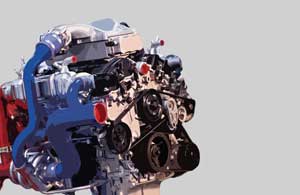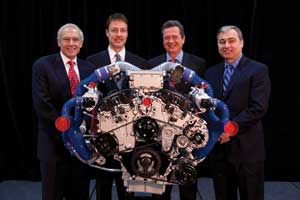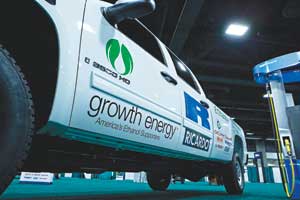A Boost to the System







June 10, 2010
BY Luke Geiver
The move to downsize wouldn't normally indicate that something big is on the way, but a team of engine developers from Ricardo Inc. is showing that in the ethanol industry, less may actually mean more. For over a year the team from Ricardo, in partnership with Growth Energy, has been developing an ethanol boost direct injection (EBDI) gasoline engine. Weighing 400 to 500 pounds less than a comparable diesel engine, the EBDI engine grew out of an interest in ethanol fuel properties and the idea of engine efficiency gained through downsizing. The nearly complete EBDI project combines fueling strategies, combustion control and ethanol boosting technology. The result: a smaller, more efficient engine optimized for ethanol that will provide better fuel economy and performance than a flex-fuel engine.
To demonstrate that these mileage gains and performance enhancements are truly happening, Growth Energy provided Ricardo with two GMC Sierra 3500 HD trucks (each with a curb weight of 6,000 pounds). The Ricardo team began recording data on the trucks with the standard engines intact. At the current stage of testing, the team has substituted the 6.0-liter V8 gasoline engine—standard in the vehicles—with a smaller EBDI-infused 3.2L V-6 and begun testing their work. "We are trying to go to the extreme end of the downsizing spectrum," says Rod Beazley, product group director for Ricardo's spark ignited engine department. "We wanted to see how much we could gain in both fuel economy and performance."
Beazley, who initially started the ethanol based engine project, says the substituted EBDI provides vastly superior performance to the standard gas engine based on tests already completed.
Ricardo's technology utilizes the latent heat of vaporation and the high octane rating of ethanol fuel to create fuel economy improvements up to 30 percent. "What we are seeing is engine technology catching up with fuel technology," says Chris Thorne, director of public affairs for Growth Energy. "This is an example of an engine leader saying they can make the leap."
The leap for Ricardo meant designing a cutting-edge engine based on a combination of pre-existing technologies, using a fuel commonly associated with less-than-optimal fuel mileage. "One of the biggest challenges we dealt with was pushing the limits of current base engines," says Luke Cruff, chief engineer of the group. "There were constraints because of what is currently used." Thorne points out that what currently exists in most vehicles, standard engines with low blends of ethanol fuel, was a trend that the team from Ricardo was not afraid to move away from. "Most flex-fuel vehicles just have a minor tweak. None of them have been optimized for fuel (ethanol) qualities," he said.
Engines such as the standard 6.0L V8 the team removed from the 1- ton demonstration truck have problems linked to what the Ricardo team calls "overfueling." To overcome this problem Beazley says the team changed and upgraded most of the major architectural components in the 3.2L V6 engine.
Cruff explains that the "overfueling" Beazley refers to happens because a typical blend of gasoline does not provide the high octane rating or have the cooling capability of ethanol blends. As the engine's cylinders build more pressure and take in more air, the cylinders become octane thirsty. The implementation of a fuel with a high latent heat of vaporation like ethanol acts as a cooling agent, reducing the temperature when the cylinders start to get "thirsty." With most engines, as the temperature rises in the cylinders, the probability of engine knock increases. The engine knock occurs as oxygen pushed into the cylinder heads detonates off the spark and high temperatures, and for most engines to reduce the knock means lowering that temperature in the cylinders. Without the reduction of the knock—that pinging sound car owners sometimes hear under high load operation—the pressure and torque created in the cylinder heads cannot remain at the intended level, and the result equals a loss in power, performance and the reduction in fuel economy as more fuel is needed to lower the temperature.
Beazley says with the EBDI system, the engine doesn't have to introduce extra fuel to keep the components cool because of the ethanol cooling agent the system injects into the cylinders. "We are focusing on improving thermal efficiency," Cruff says. The EBDI takes advantage of engine control algorithms that detect both the amount of needed ethanol and the proper time to inject the fuel. Along with the injection system, the engine uses an exhaust gas recirculation system that helps to control the temperature levels of the engine and the tailpipe emissions.
The combination of the ethanol injector technology, exhaust gas recirculation system, and the ability to measure how much of the ethanol is needed at a particular time has the Ricardo team excited about the implications of their work. Beazley says the project started out of his interest in the octane rating of ethanol, and now has Ricardo President Kent Niederhofer willing to say that the EBDI could eventually replace conventional engines.
Rod Harris, another chief engineer working on the engine, points to the performance numbers as a reason to agree. "There is an extreme level of performance with this engine. The EBDI engine using E85 will produce 900 newton meters of peak torque with 450 plus horsepower while a regular engine using pump gasoline will produce 775 newton meters of peak torque with 400 horsepower," Harris says.
And the performance gains aren't limited to one type of ethanol blended fuel or one size of engine according to Harris. "We think this technology is scalable. We can take the engine technology and scale it down to fit a passenger car," Harris says. "The goal is to run on whatever fuel the engine has been given. EBDI controls the fueling, the spark timing, and the EGR rate. Ultimately, no matter what blend of fuel, the engine will always be running at an optimal level."
The multiple application possibilities of the EBDI system also have Growth Energy enthused by the implications of what the Ricardo team has created. "You could put the technology in a tractor, a bus, the back of a skid steer and it is much more cost effective than a diesel," Thorne says. After starting the research, the Ricardo team recognized early on that their work could reach a wide spectrum of vehicle owners. To ensure that the technology will function and perform to the team's desired level, the GMC trucks are now being put to the test outside of the lab. "We wanted to get this into running demonstrator vehicles," Beazley says. He explains that although the current testing results speak for themselves, there are still those who doubt the achievements of the EBDI. A trip to the 2010 Washington Auto Show helped to cure that problem.
"At the show people were curious," Thorne explains. But like many people who didn't attend the show, Thorne says, there were also those who doubted the ethanol optimized engine. "All they had to see was the return on the mileage and they were onboard."
In early fall, the team will have completed final testing on the engine in the heavy duty trucks, testing they say will solidify what the engine can do. In store for the engine this summer is a range of tests including extreme climate conditions of arid, desert situations and below-zero temperatures, as well as city stop-and-go driving. Until the testing is complete, the team plans to showcase their technology with one goal in mind. "Getting our message out to a broader audience is what we are trying to do," Beazley says. EP
Luke Geiver is an associate editor of Ethanol Producer Magazine. Reach him at (701) 738-4944 or lgeiver@bbiinternational.com.
To demonstrate that these mileage gains and performance enhancements are truly happening, Growth Energy provided Ricardo with two GMC Sierra 3500 HD trucks (each with a curb weight of 6,000 pounds). The Ricardo team began recording data on the trucks with the standard engines intact. At the current stage of testing, the team has substituted the 6.0-liter V8 gasoline engine—standard in the vehicles—with a smaller EBDI-infused 3.2L V-6 and begun testing their work. "We are trying to go to the extreme end of the downsizing spectrum," says Rod Beazley, product group director for Ricardo's spark ignited engine department. "We wanted to see how much we could gain in both fuel economy and performance."
Beazley, who initially started the ethanol based engine project, says the substituted EBDI provides vastly superior performance to the standard gas engine based on tests already completed.
Ricardo's technology utilizes the latent heat of vaporation and the high octane rating of ethanol fuel to create fuel economy improvements up to 30 percent. "What we are seeing is engine technology catching up with fuel technology," says Chris Thorne, director of public affairs for Growth Energy. "This is an example of an engine leader saying they can make the leap."
The leap for Ricardo meant designing a cutting-edge engine based on a combination of pre-existing technologies, using a fuel commonly associated with less-than-optimal fuel mileage. "One of the biggest challenges we dealt with was pushing the limits of current base engines," says Luke Cruff, chief engineer of the group. "There were constraints because of what is currently used." Thorne points out that what currently exists in most vehicles, standard engines with low blends of ethanol fuel, was a trend that the team from Ricardo was not afraid to move away from. "Most flex-fuel vehicles just have a minor tweak. None of them have been optimized for fuel (ethanol) qualities," he said.
Engines such as the standard 6.0L V8 the team removed from the 1- ton demonstration truck have problems linked to what the Ricardo team calls "overfueling." To overcome this problem Beazley says the team changed and upgraded most of the major architectural components in the 3.2L V6 engine.
Cruff explains that the "overfueling" Beazley refers to happens because a typical blend of gasoline does not provide the high octane rating or have the cooling capability of ethanol blends. As the engine's cylinders build more pressure and take in more air, the cylinders become octane thirsty. The implementation of a fuel with a high latent heat of vaporation like ethanol acts as a cooling agent, reducing the temperature when the cylinders start to get "thirsty." With most engines, as the temperature rises in the cylinders, the probability of engine knock increases. The engine knock occurs as oxygen pushed into the cylinder heads detonates off the spark and high temperatures, and for most engines to reduce the knock means lowering that temperature in the cylinders. Without the reduction of the knock—that pinging sound car owners sometimes hear under high load operation—the pressure and torque created in the cylinder heads cannot remain at the intended level, and the result equals a loss in power, performance and the reduction in fuel economy as more fuel is needed to lower the temperature.
Beazley says with the EBDI system, the engine doesn't have to introduce extra fuel to keep the components cool because of the ethanol cooling agent the system injects into the cylinders. "We are focusing on improving thermal efficiency," Cruff says. The EBDI takes advantage of engine control algorithms that detect both the amount of needed ethanol and the proper time to inject the fuel. Along with the injection system, the engine uses an exhaust gas recirculation system that helps to control the temperature levels of the engine and the tailpipe emissions.
The combination of the ethanol injector technology, exhaust gas recirculation system, and the ability to measure how much of the ethanol is needed at a particular time has the Ricardo team excited about the implications of their work. Beazley says the project started out of his interest in the octane rating of ethanol, and now has Ricardo President Kent Niederhofer willing to say that the EBDI could eventually replace conventional engines.
Rod Harris, another chief engineer working on the engine, points to the performance numbers as a reason to agree. "There is an extreme level of performance with this engine. The EBDI engine using E85 will produce 900 newton meters of peak torque with 450 plus horsepower while a regular engine using pump gasoline will produce 775 newton meters of peak torque with 400 horsepower," Harris says.
And the performance gains aren't limited to one type of ethanol blended fuel or one size of engine according to Harris. "We think this technology is scalable. We can take the engine technology and scale it down to fit a passenger car," Harris says. "The goal is to run on whatever fuel the engine has been given. EBDI controls the fueling, the spark timing, and the EGR rate. Ultimately, no matter what blend of fuel, the engine will always be running at an optimal level."
The multiple application possibilities of the EBDI system also have Growth Energy enthused by the implications of what the Ricardo team has created. "You could put the technology in a tractor, a bus, the back of a skid steer and it is much more cost effective than a diesel," Thorne says. After starting the research, the Ricardo team recognized early on that their work could reach a wide spectrum of vehicle owners. To ensure that the technology will function and perform to the team's desired level, the GMC trucks are now being put to the test outside of the lab. "We wanted to get this into running demonstrator vehicles," Beazley says. He explains that although the current testing results speak for themselves, there are still those who doubt the achievements of the EBDI. A trip to the 2010 Washington Auto Show helped to cure that problem.
"At the show people were curious," Thorne explains. But like many people who didn't attend the show, Thorne says, there were also those who doubted the ethanol optimized engine. "All they had to see was the return on the mileage and they were onboard."
In early fall, the team will have completed final testing on the engine in the heavy duty trucks, testing they say will solidify what the engine can do. In store for the engine this summer is a range of tests including extreme climate conditions of arid, desert situations and below-zero temperatures, as well as city stop-and-go driving. Until the testing is complete, the team plans to showcase their technology with one goal in mind. "Getting our message out to a broader audience is what we are trying to do," Beazley says. EP
Luke Geiver is an associate editor of Ethanol Producer Magazine. Reach him at (701) 738-4944 or lgeiver@bbiinternational.com.
Advertisement
Advertisement
Advertisement
Advertisement
Upcoming Events





